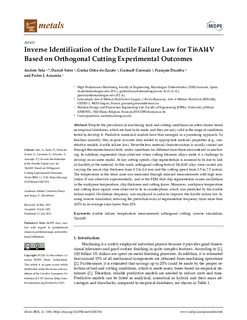| dc.rights.license | Attribution 4.0 International | * |
| dc.contributor.author | Sela, Andrés | |
| dc.contributor.author | Soler Mallol, Daniel | |
| dc.contributor.author | Ortiz-de-Zarate, Gorka | |
| dc.contributor.author | ARRAZOLA, PEDRO JOSE | |
| dc.contributor.other | Germain, Guénaël | |
| dc.contributor.other | Ducobu, François | |
| dc.date.accessioned | 2021-07-22T08:23:28Z | |
| dc.date.available | 2021-07-22T08:23:28Z | |
| dc.date.issued | 2021 | |
| dc.identifier.issn | 2075-4701 | en |
| dc.identifier.other | https://katalogoa.mondragon.edu/janium-bin/janium_login_opac.pl?find&ficha_no=164434 | en |
| dc.identifier.uri | https://hdl.handle.net/20.500.11984/5348 | |
| dc.description.abstract | Despite the prevalence of machining, tools and cutting conditions are often chosen based on empirical databases, which are hard to be made, and they are only valid in the range of conditions tested to develop it. Predictive numerical models have thus emerged as a promising approach. To function correctly, they require accurate data related to appropriate material properties (e.g., constitutive models, ductile failure law). Nevertheless, material characterization is usually carried out through thermomechanical tests, under conditions far different from those encountered in machining. In addition, segmented chips observed when cutting titanium alloys make it a challenge to develop an accurate model. At low cutting speeds, chip segmentation is assumed to be due to lack of ductility of the material. In this work, orthogonal cutting tests of Ti6Al4V alloy were carried out, varying the uncut chip thickness from 0.2 to 0.4 mm and the cutting speed from 2.5 to 7.5 m/min. The temperature in the shear zone was measured through infrared measurements with high resolution. It was observed experimentally, and in the FEM, that chip segmentation causes oscillations in the workpiece temperature, chip thickness and cutting forces. Moreover, workpiece temperature and cutting force signals were observed to be in counterphase, which was predicted by the ductile failure model. Oscillation frequency was employed in order to improve the ductile failure law by using inverse simulation, reducing the prediction error of segmentation frequency from more than 100% to an average error lower than 10%. | es |
| dc.description.sponsorship | Gobierno de España | es |
| dc.description.sponsorship | Gobierno Vasco | es |
| dc.language.iso | eng | en |
| dc.publisher | MDPI | en |
| dc.rights | © 2021 by the authors. Licensee MDPI | en |
| dc.rights.uri | http://creativecommons.org/licenses/by/4.0/ | * |
| dc.subject | ductile failure | en |
| dc.subject | temperature measurement | en |
| dc.subject | Orthogonal cutting | en |
| dc.subject | inverse simulation | en |
| dc.title | Inverse Identification of the Ductile Failure Law for Ti6Al4V Based on Orthogonal Cutting Experimental Outcomes | en |
| dcterms.accessRights | http://purl.org/coar/access_right/c_abf2 | en |
| dcterms.source | Metals | en |
| local.contributor.group | Mecanizado de alto rendimiento | es |
| local.description.peerreviewed | true | en |
| local.identifier.doi | https://doi.org/10.3390/met11081154 | en |
| local.relation.projectID | GE/Convocatoria 2018 de proyectos de I+D+i «Retos Investigación», del Programa Estatal de I+D+i Orientada a los Retos de la Sociedad, en el marco del Plan Estatal de Investigación Científica y Técnica y de Innovación 2017-2020/RTI2018-094435-B-C31/ES/Fabricación aditiva de compuestos termoplásticos reforzados con fibra para transporte, salud y deporte/ | en |
| local.relation.projectID | GE/Convocatoria 2018 de proyectos de I+D+i «Retos Investigación», del Programa Estatal de I+D+i Orientada a los Retos de la Sociedad, en el marco del Plan Estatal de Investigación Científica y Técnica y de Innovación 2017-2020/RTI2018-095463-B-C21/ES/Ingeniería de Superficies a través del mecanizado enfocado a materiales empleados en la aeronáutica y la automoción: proceso de mecanizado enfocado al material | en |
| local.relation.projectID | GV/Convocatoria de ayudas a la Investigación básica y-o aplicada 2018-2020/PIBA 2018-85/CAPV/Desarrollo de banco de ensayos de mecanizado lineal de alta velocidad para análisis de la condición de integridad superficial de aleaciones aeronáuticas y validación de modelos predictivos del proceso de corte/MECAERO | en |
| local.relation.projectID | GV/Elkartek 2020/KK-2020-00001/CAPV/Investigación estratégica en tecnologías emergentes para el desarrollo de superficies avanzadas/nG20 | en |
| local.relation.projectID | in | en |
| local.rights.publicationfee | APC | en |
| local.rights.publicationfeeamount | 1660 EUR | en |
| local.contributor.otherinstitution | https://ror.org/02qnnz951 | es |
| local.contributor.otherinstitution | https://ror.org/018pp1107 | es |
| local.source.details | Vol. 11. N. 8. N. artículo 1154, | en |
| oaire.format.mimetype | application/pdf | |
| oaire.file | $DSPACE\assetstore | |
| oaire.resourceType | http://purl.org/coar/resource_type/c_6501 | en |
| oaire.version | http://purl.org/coar/version/c_970fb48d4fbd8a85 | en |








